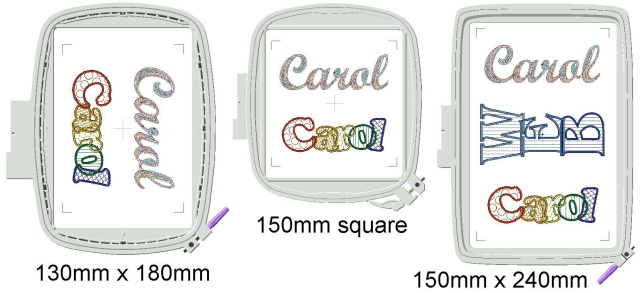Individual characters (letters, numbers and punctuation marks) from my alphabets can
be found on my Stock Design Page. My designs are also available in packs, as described in
this blog. Those can be found here. For designs and packs available in multiple sizes,
choose the size you want in the drop down menu box.
Machine embroidery is an expensive craft. We have to buy our embroidery
machines, then designs and/or software for creating and adapting designs, special threads,
and finally stabilizers. It is difficult to reduce expenses on most of these necessities and still
get good results, but I’ve figured out a way to economize on stabilizer. I would like to share
this technique with you, and have written a lesson (see below) for this purpose.
I named my technique Piggyback Hooping because one design rides right behind another.
The technique—in which multiple designs are stitched in a single hooping—not only uses
the hooped stabilizer more completely, but reduces the number of times we must hoop in
order to stitch the same number of designs. Moreover, the amount of stabilizer that sits
outside the hoop is not wasted multiple times as it would be if we hooped each design
separately.
The figure below shows examples of some common hoop sizes. Note that two or more
designs can fit in the hoop, depending on the size of the hoop and the sizes of the designs.
For the Piggyback Hooping lesson I used the 150mm x 240mm hoop and the three designs
you see pictured in it. However, you can easily adapt my instructions to any size of hoop.

To decide if my technique will help you, here are some things to consider when you set out
to embroider. First, each design must use only a small portion of the available hoop area.
This is just a matter of real estate! If one design nearly fills the hoop, there will be not
enough room for another design.
Second, the fabric must be open and easy to maneuver in the hoop. It is easier to sew
designs on two pieces of fabric for tote bags than it is to hoop two tote bags. I would not
suggest Piggyback Hooping for embroidery on winter coats, quilts, or other bulky items.
The hoop would not be able to support the weight of all that fabric and it would be very
hard to position the second design. You will need to move the excess fabric aside after
em-broidering a design, in order to make room for the next piece of fabric.
Finally, the same type and weight of stabilizer must be appropriate for all the designs and
fabrics. Tearaway, cutaway and washaway stabilizers work best for different types of
embroideries and fabrics, as we sometimes learn the hard way. There is no economy if our
designs stitch out poorly.
The embroideries you will see in the lesson are for my Zip-Around Eyeglass Cases. (I plan
to tell you more about those in a future blog—please stay tuned!) However, the Piggyback
Hooping technique is just as useful for many other small designs and projects. For
example, the pillowcases and the double pockets projects I shared in the past are suitable for
small embroidery designs; I’m sure you’ll think of many other projects, too. In fact, with all
the money you save on stabilizer, you’ll be able to acquire more of my alphabets! 
You will need the following items:
- Embroidery thread.
- Embroidery designs such as my Fancy Jumbles, Pinstripes, and Contour Script alphabets.
- Stabilizer
- Fade-away or Wash-away marking pen or tailor’s chalk (for marking right side of fabric).
- Fabrics required for projects.
- Flexible plastic ruler with 1/8” grid (available at office supply stores).
- Finally, you can download the complete instructions here.
— Carol